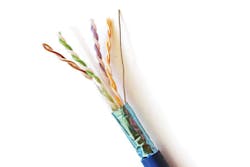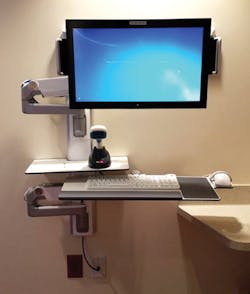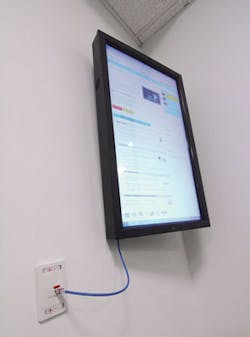PoE-enabled computing: The next step in the digital building
By Valerie Maguire, Siemon and Ravi Ramanuja, Thinlabs
Digital buildings are here to stay. Driven by intelligent systems that integrate and control all elements of an office digitally, smart building solutions can allocate work areas and conference rooms, control lighting, cool or heat occupied workspace, operate digital security systems, and provide wireless access to employees and guests. The result is an environment that is measurable, controllable and green.
IP convergence is the mantra of the digital building. The concept of using a single IP network to replace as many as eight or nine different systems, each having proprietary wiring, connectors, pathways, and “service experts,” is a no-brainer. Not only is the approach more cost effective, but it is safer because these solutions can integrate low-voltage remote powering technology, such as Power over Ethernet or PoE. Further, PoE technology consumes less power and features greater efficiency due to fewer AC-to-DC conversion losses, which makes it an attractive proposition for businesses and offices.
The next generation of computing devices
The digital building now has a new (old) component - the computer. Offices are built around the computer; it’s the most important item on your desk. Additionally, if most of the IP-enabled devices in the building are interconnected and powered by Ethernet cabling, installing unneeded electrical mains cabling outlets at floor level (or desk level) seems antiquated.
PoE computing is the next step in the digital building. The advantages of being able to power thin client, desktop, and larger mobile devices has repeatedly been used as rationale to justify development of higher-power delivery applications such as emerging IEEE 802.3bt Type 3 60W and Type 4 90W PoE. However, until just recently, the benefits of 60W and higher power have been primarily discussed in the context of PoE lighting and digital signage. The PoE ecosystem is about to change drastically with the emergence of cost-effective PoE-enabled desktop computers.
PoE computing, as the name suggests, is the powering of computers with a standard Ethernet cable and the traditional RJ45 connector - no 120 V/60 Hz electrical mains connection is required. This technology represents the next generation of Power over Ethernet convergence, and these critical devices are just starting to become incorporated into the digital building envelope. There have been many versions of PoE computers that have been introduced over the years, particularly after IEEE 802.3at Type 2 PoE was ratified, but these have been limited to devices with very small screens, with restricted processing power, and used only for specific applications such as signage displays.
Moore’s Law of computing means that processors become more powerful while using less energy. This has given rise to a new generation of computers that not only use less energy but also possess greater computing power than before. In addition, LED screen technology continues to improve while using less power. This means that we now have full computers with large (22- and 24-inch) and high-definition (HD) screens that are capable of running all workplace applications such as office productivity suites and HD video. These devices can replace most computers that are in use in offices and companies worldwide at similar or better performance, while significantly lowering installation and ongoing operational costs.
Today’s PoE-enabled computers use 30W Type 2 PoE and 60W Type 3 PoE (e.g. Cisco UPOE) remote powering technology. The combination of higher power availability via the switch and reduced power requirements for key components such as processors and screens means that these computers are more powerful than ever before. These devices support x86 processors (which means they can run traditional computer operating systems with 64-bit or 32-bit computing such as Windows and most versions of Linux). They use touch screens or traditional peripherals such as keyboards, mice, and trackpads, and network connectivity is provided via 10-Gbit/sec-capable balanced twisted-pair cabling. In instances where mobility is more important than network speed, organizations may use the Ethernet connection for power only and use a wireless network for connectivity, although these instances are few and far between. As a result, PoE computers have the flexibility to be used either as traditional “fat” desktops running Windows 10 Professional or as virtual “thin” devices running on a client-server model.
The many benefits of PoE computing
The reasons for the anticipated rapid adoption of PoE computing technology are far-ranging, and include the following.
Operation over installation-friendly and familiar media - PoE computers are powered and connected to the IP network with familiar and user-friendly TIA and ISO/IEC specified high-performance balanced twisted-pair cabling (Category 6A and higher recommended). No new training or credentials are required for cabling installers and technicians to pull new PoE computer connections. PoE computing is an extension of the existing IT network service and may possibly even be a new revenue stream for installers.
Safe to use and implement - PoE is a safety extra-low voltage (SELV) application, which makes it inherently safe to use in all workplace, school and university, healthcare, residential, and other environments. 120 V/60 Hz electrical outlets are not needed to power and/or charge PoE computers.
More cost effective - By eliminating the need for expensive electrical outlet connections, electrical wiring, permits, and specially certified or licensed contractors, PoE computing will help organizations significantly reduce costs. The further reduction of “soft” costs, such as procurement, transportation, and storage, results in even more savings.
Speed up project timelines - Because deployment of electrical mains cabling is not required, new PoE computers can be installed in hours or days instead of weeks, reducing project timelines by high margins and speeding up time to productivity.
Greener solution - PoE computers are among the most energy-efficient computers in the world and consume on average less than half the power of an equivalent desktop computer. Combine this energy-efficient performance with the elimination of electrical cabling materials, and PoE computers are clearly the must-have solution for environmentally conscious enterprise customers.
Increased flexibility - Moving computers around, especially in dynamic companies, or adding devices when an organization grows, is quick and easy when using PoE computers.
Redundant power - UPS systems can be configured to provide backup power to the PoE switch, which means that connected computers (and other devices running on PoE) will continue to operate in the event of a power outage.
Where do we go from here?
The number of PoE-enabled switching solutions will continue to grow and equipment costs will continue to decrease. Ratification of the IEEE 802.3bt 60W Type 3 PoE and 90W Type 4 PoE remote power delivery standards is expected next year, and the ability to use 60W and higher PoE technology will continue to facilitate rapid changes to the computing industry. Among these and many other advancements, it is expected that the following will be true.
- Faster and more powerful computers will be developed to run on PoE; the cost savings are too good to ignore and the benefits are compelling.
- Higher power availability will enable multiscreen systems that can simultaneously power two or more screens and a computer using one PoE port.
- Based on the current component power usage, it is likely that devices with 42-inch, and possibly even 46-inch screens, will become commercially viable. Emerging and more-efficient screen technology could support even larger displays.
- PoE screens and computing solutions will play an important role in digital signage applications.
Recommended cabling for PoE computer connections
PoE computers are high-speed, high-performance devices, and optimum performance can only be realized if care and consideration are given to how these systems are connected to the IT network. The cabling infrastructure to which these devices are connected must be capable of supporting both 10GBase-T and up to 100W remote powering applications in the dense pathway and bundled configurations commonly found in enterprise deployments. While there are some instances in which the installed base of cabling can support 10GBase-T, TIA and ISO/IEC are very clear in their position that Category 6A (or higher) balanced twisted-pair cabling should be used for all new installations intended to support the 10GBase-T application. Additionally, connecting hardware must be properly designed and qualified (compliance to IEC 60512-99-001 is recommended by TIA and ISO/IEC standards) to prevent contact damage when unmating under PoE load to ensure reliable support of PoE computing devices.
There is also the additional consideration of whether to specify unshielded or shielded media for support of PoE computing applications. Because the resistance of the copper twisted pairs causes electrical losses to manifest as heat when 60W and higher remote powering solutions are deployed, the environment where these cables are deployed (e.g. bundled in pathways) and the implications of heat buildup (e.g. the need to reduce overall channel length to offset insertion loss at elevated temperatures) should be considered in the media-selection process.
Shielded Category 6A cabling is similar to an unshielded cable with the exception that an overall foil surrounds the four twisted pairs. This construction, often referred to as F/UTP, offers benefits for both high-frequency noise immunity and superior heat dissipation when supporting 60W and higher remote powering applications. In fact, the extremely stable transmission performance at elevated temperatures and current-carrying capacity of shielded Category 6A cable enables less-restrictive building practices, reduces the need for channel-length derating in elevated temperature environments, and may eliminate the need for special jacket constructions (e.g. LP-rated) in high-density environments. Because of these advantages, shielded Category 6A cable is recommended for PoE computer connections.
Use cases
Because of the unique advantages that they offer, PoE computers can replace most existing desktop computers with many industries standing to benefit. Here are some examples.
Healthcare - The safety (no electrical outlet required for charging), lower cost of implementation, and consolidated power backup means that mission-critical PoE computers can be kept on and available all the time. One of the largest users of PoE computers in the market today is the healthcare vertical with varied uses ranging from nurses’ stations to patient entertainment systems.
Manufacturing - PoE computers are often deployed in manufacturing environments where electrical power points can be expensive and difficult to implement and access. The lack of a 120 V/60 Hz mains electrical connection makes it safer to use in these environments.
Financial services - The advantage of fewer cables makes for a less-cluttered desktop and better customer experience in financial service providers such as banks and insurance companies. Wired Ethernet networks also ensure greater security. Additionally, the lower power consumption and UPS-supplied backup power through the switch ensures that data reliability is prioritized. PoE computers’ flexibility of movement can be useful in an industry characterized by dynamic team sizes and projects.
Retail - PoE computers reduce operating costs and implementation timelines for deployment of digital signage and kiosks.
Universities/colleges/schools - PoE devices are an excellent fit in colleges and schools due to low power and safe low-voltage operation (i.e. no electrical outlet required for charging). Universities are a fast-growing market for deployment of PoE computers for desktops, as well as kiosks.
Middlesex Hospital
Middlesex Hospital is a not-for-profit, acute-care community hospital and part of the Mayo Clinic Care Network located in Middletown, CT. Its service area has a population of more than 250,000 people. The hospital was looking for a computing solution that would be used by doctors for consultation in visitation chambers and was attracted by the safety, convenience, and ease of installation of PoE computers.
It was critical that the devices supported Windows OS in 1920x1080 (full HD) resolution in a desktop format, so tablets and other handheld devices were not under consideration. It was determined that a 22-inch Thinlabs PoE computer could ideally serve the hospital’s performance needs and offer the added benefits of reduced number of cables in the work area (because data and power are supplied over a single Ethernet cable) and the provision of centralized backup power via the data switches.
Because the hospital caters to a large number of people in the area, including young children, the appeal of PoE as a low-voltage solution with reduced risk by eliminating electrical outlets required for charging was very attractive. Furthermore, because Thinlabs PoE computers feature anti-bacterial plastics that inhibit bacterial growth, they are ideal for deployment in hospitals and healthcare environments.
Currently, Middlesex Hospital has about 66 quad-core PoE computers powered by Cisco UPOE switches, which are expected to be fully compliant with 60W Type 3 PoE via a software upgrade when IEEE 802.3bt publishes next year. The hospital plans to roll out additional devices to support multi-purpose patient visitation systems in the future.
The exciting opportunities and capabilities that PoE-enabled computing solutions can offer to enterprise customers promise to change the digital building landscape. The cost savings, energy efficiency, green, rapid rollout, decreased desktop clutter, increased safety due to elimination of electrical outlets, and mobility benefits uniquely provided by this technology are absolute game-changers. While 30W is sufficient for first-generation PoE-enabled computing devices, the ability to take advantage of 60W and 90W PoE delivery systems will enable multiscreen display and presentation capability, as well as the ability to support larger monitors and digital signage, making other forms of traditionally powered computing and display solutions obsolete. Buildings with a shielded Category 6A cabling infrastructure already in place will be optimally prepared to support the high-bandwidth transmission and remote powering current and thermal capacity requirements of present and future generations of PoE-enabled desktop computing technology.
Valerie Maguire is global sales engineer for Siemon (www.siemon.com). Ravi Ramanuja is EMEA regional manager for Thinlabs (www.thinlabs.com).




